DUNE prototype activities at the Neutrino Platform
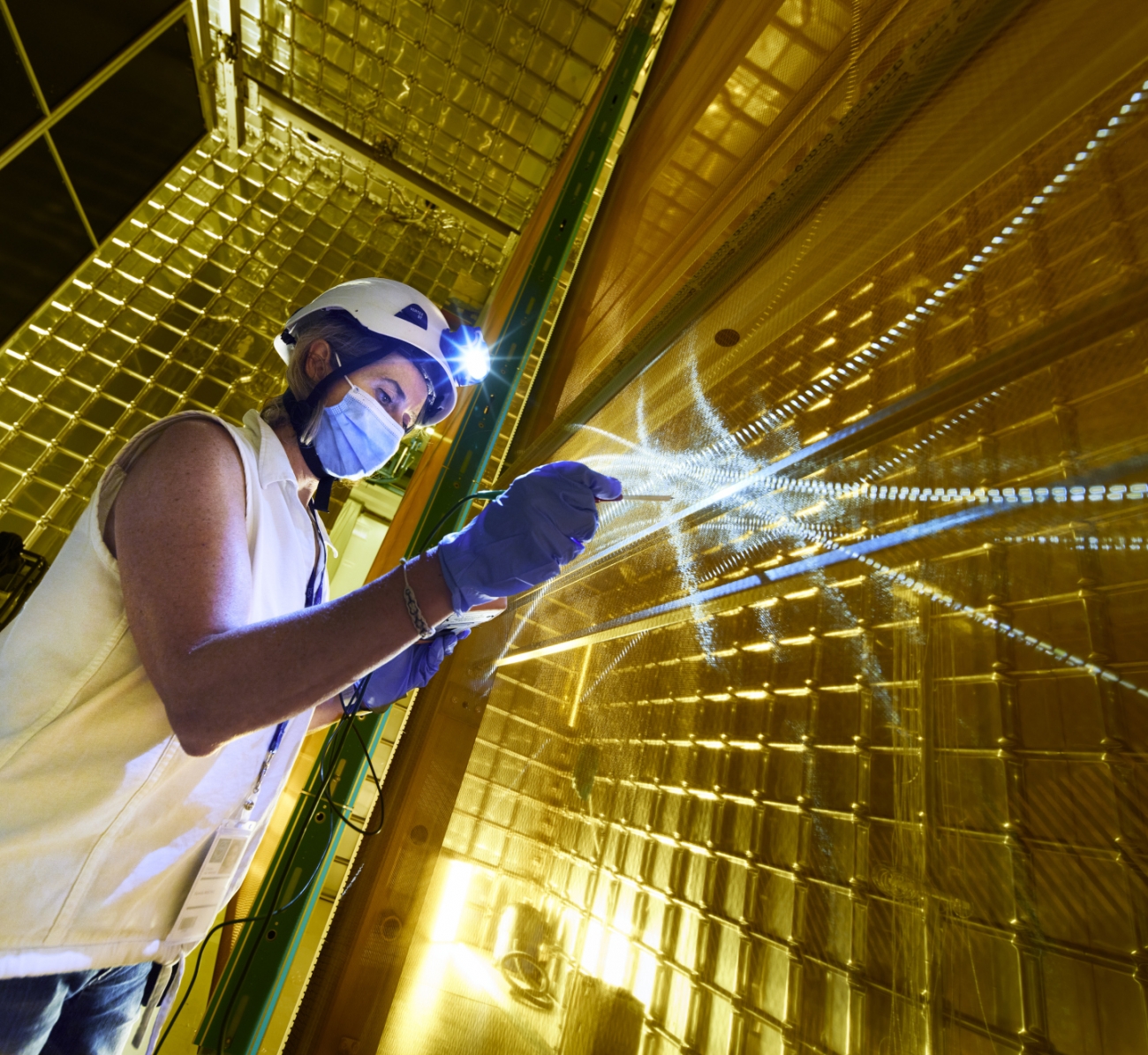
The Deep Underground Neutrino Experiment (DUNE), now under construction, is a long baseline neutrino experiment with a near detector at Fermilab and far detector at the Sanford Underground Research Facility in South Dakota to observe neutrinos produced by a new beam at Fermilab. DUNE will make precision measurements of neutrino oscillation physics, study supernovae that occur in or near our galaxy and search for physics beyond the Standard Model, e.g. additional types of neutrinos. At the CERN Neutrino Platform , two large DUNE far detector prototypes (NP02 and NP04) have been constructed and tested over the last few years. We provide an overview of these activities and plans.
ProtoDUNE-SP (NP04), the single-phase Horizontal Drift DUNE Far Detector prototype at the CERN Neutrino Platform, successfully operated from August 2018 to July 2020 in the CERN EHN1 experimental area [see EP news article], validating the Liquid Argon Time Projection Chamber (LArTPC) technology choice for the multi-kt DUNE Far Detector 1 (FD1-HD). With its ~750 tonnes of LAr, ProtoDUNE is the largest LArTPC ever operated. During operations, the LArTPC was exposed to charged particle beams, with momentum in the range of 0.3-7 GeV, and to cosmic rays. The first analyses of these large beam data samples from 2018, and cosmic ray samples from long term operations in 2019-2020 demonstrate performance that meets or exceeds the DUNE far detector requirements [see First results on ProtoDUNE-SP liquid argon time projection chamber performance from a beam test at the CERN Neutrino Platform], often by a large margin. Details of the ProtoDUNE-SP construction, installation and operations, as well as the first performance results, have been published in JINST 17 (2022) 01, P01005 and JINST 15 (2020) P12004.
Following two years of successful operation and outstanding results, the NP04 cryostat was emptied from 22 July 2020 until 24 October 2020 marking the completion of ProtoDUNE-SP Phase I (ProtoDUNE-I).
The DUNE collaboration, based on experience from ProtoDUNE-I, is advancing toward the construction of DUNE with production of Single Phase Far Detector components for the Module-0 detector, which will be tested in ProtoDUNE Phase-II (ProtoDUNE-II). The new designs have successfully passed preliminary design reviews. ProtoDUNE-II will also test proposed calibration techniques, including a laser calibration system and a pulsed neutron source, which was previously deployed only in the very last weeks of ProtoDUNE-I operations. Finally, ProtoDUNE-II will collect more beam data (including complete data sets with negative charged particles in momentum range 0.3-7 GeV), with particular emphasis on lower beam momenta. The ProtoDUNE-II configuration will use the ProtoDUNE-I cryostat with an improved cryogenics system (based on experience from ProtoDUNE-SP and ProtoDUNE-DP). As much as possible, the final DUNE Far Detector components and layout will be implemented. The present schedule foresees completion of ProtoDUNE-II installation in July 2022, with LAr filling in August 2022 and beam data taking in autumn 2022.
ProtoDUNE-II activities were initiated in November 2020 with the decommissioning of ProtoDUNE-I. As soon as the cryostat was emptied of LAr, warmed to room temperature and injected with breathable air, visual inspections were performed, (personnel access via the cryostat manhole). These confirmed that the detector was not degraded by the cryogenic thermal cycles and long-term operation at LAr temperature. The cryostat was opened by February 2021 and all detector components were removed from the cryostat by September 2021. The opening and re-closing of the cryostat involves development of new techniques and procedures not commonly used in the cryostat industry. These techniques were refined to reduce the time required to complete detector installation, allowing a quicker start-up of ProtoDUNE-II operations.
The decommissioning of the detector during the COVID-19 pandemic period has been challenging. All operations had to be carried out by the local CERN team since international travel was halted. Video calls with experts across around the world were necessary to ensure that decommissioning operations were completed efficiently. Ιt was necessary to preserve the integrity of the many detector parts planned for reuse or upgrade for ProtoDUNE-II. Several other components underwent careful inspection as part of the lessons-learned process. In November 2021 the first Module-0 Anode Plane Assembly (APA) was delivered to CERN and cooled down in the NP04 cold box to 150 K with cold nitrogen gas. The successful completion of this testing in December 2021 allowed DUNE to reach an important milestone tied to the validation of the overall detector design. Navigating this milestone paves the way for initiating full-scale production of components for the first DUNE Far Detector.
ProtoDUNE-II is a major undertaking, requiring a strong team to implement (on par with what was required for ProtoDUNE-I). This year (2022) is expected to be very intense and challenging. Detector components and international teams are expected to arrive at the CERN Neutrino Platform in force during spring 2022, bringing life back to the assembly hall at pre-pandemic levels.

Decommissioning of NP04 phase-I with open TCO and part of the FC removed (left). Checking the integrity of the APA wires (center). Insertion of the new APA in coldbox for cryogenic test (right).
NP02, the twin cryostat of NP04, hosted a prototype of dual phase (liquid-vapor) argon TPC (ProtoDUNE-DP) in 2019-2020. This detector saw the first large scale application of Printed Circuit Boards (PCBs) instead of wire planes for readout of the ionization signals in the DUNE prototypes. The use of PCBs simplifies detector construction and also achieved gain in the gas phase of ProtoDUNE-DP. Electrons extracted from the liquid to the gas phase were collected on strips implemented on segmented anode PCBs in units of 50 cm x 50 cm coupled to perforated PCB, the Large Electron Multipliers (LEMs), which enabled signal amplification in the vapor by means of a type of Micropattern Gaseous Detector technology. Thirty-six LEM and anode PCB sandwiches were assembled to cover readout surfaces of 3 m x 3 m, called Charge Readout Planes (CRP).
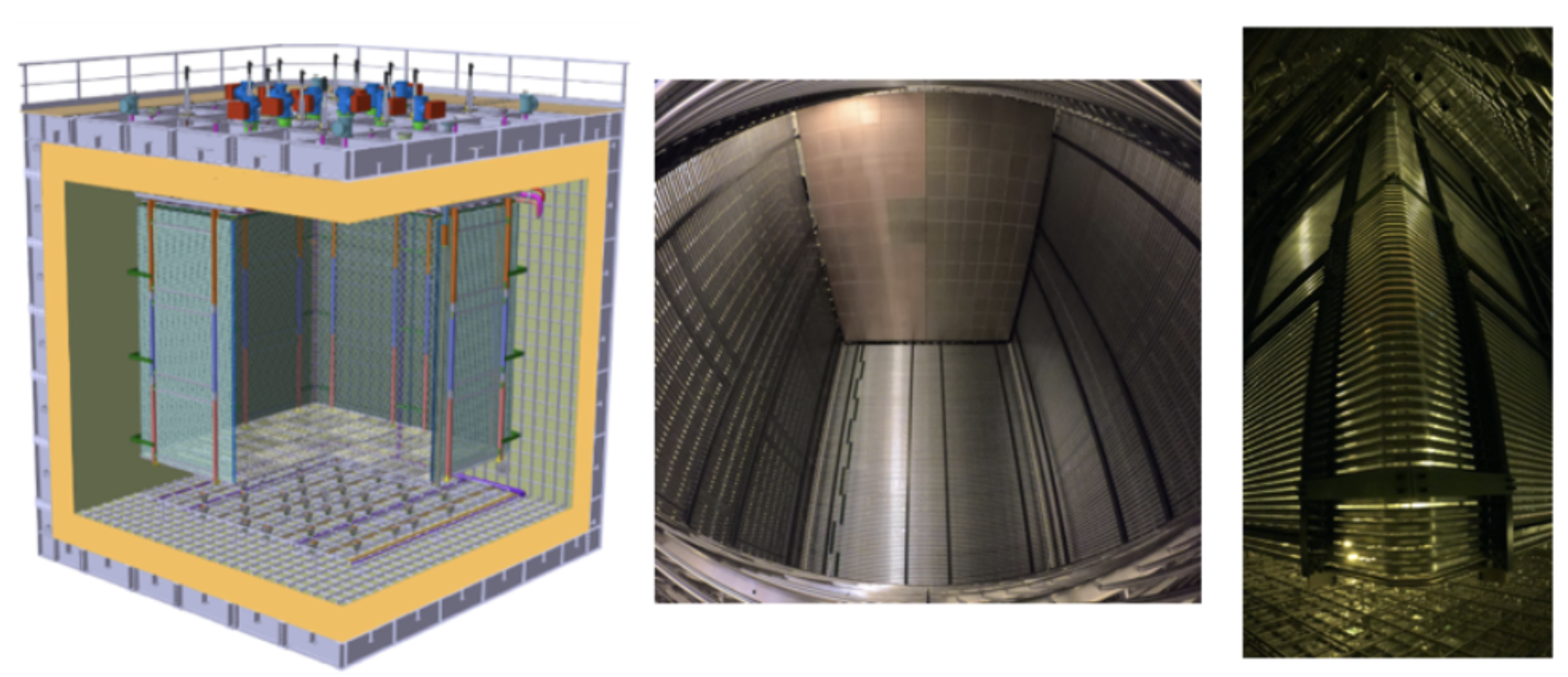
Schematic of the NP02 800 t cryostat (left). Fish-eye picture from the cathode, showing the Field Cage (FC) and the anode of the ProtoDUNE-DP detector (center).Detail of a FC corner from the outside (right).
Capitalizing on the important ProtoDUNE-SP and ProtoDUNE-DP R&D in the NP02 and NP04 cryostats over the last four years , new solutions emerged for the second DUNE Far Detector (FD2) module. The high level of liquid argon purity achieved in these cryostats exceeded requirements, allowing longer drift lengths with respect to what was tested in ProtoDUNE-SP. Charge readout electronics in both NP04 and NP02 demonstrated excellent signal to noise ratio, proving that signal amplification in vapor is not required. The vertical drift layout of NP02 (installation of horizontal anodes and cathode) results in a more effective use of the liquid argon volume: it simplifies the mechanics of the detector components and the installation procedures while reducing the time-schedule and financial risks.
The design of DUNE-FD2 implements a LArTPC with a vertical drift layout (FD2-VD), exploiting PCBs for charge readout in a simplified layout. This alternative design features a horizontal cathode plane at mid-height in the active volume of the cryostat, dividing it into two vertically separated volumes, each 6.5 m in height. The anode planes are constructed of perforated PCBs with etched electrodes forming a three-view charge readout. The top anode plane is placed close to the cryostat top, just below the surface of the LAr, and the other is located as close to the bottom of the cryostat as possible. Ionization electrons drift vertically towards the anode planes at the end of the drift volume. The FD2-VD design offers a somewhat larger instrumented volume (60.0 m × 13.5 m × 13.0 m) compared to the FD1-HD design and simpler, more cost-effective construction and installation due to its geometry and structure.
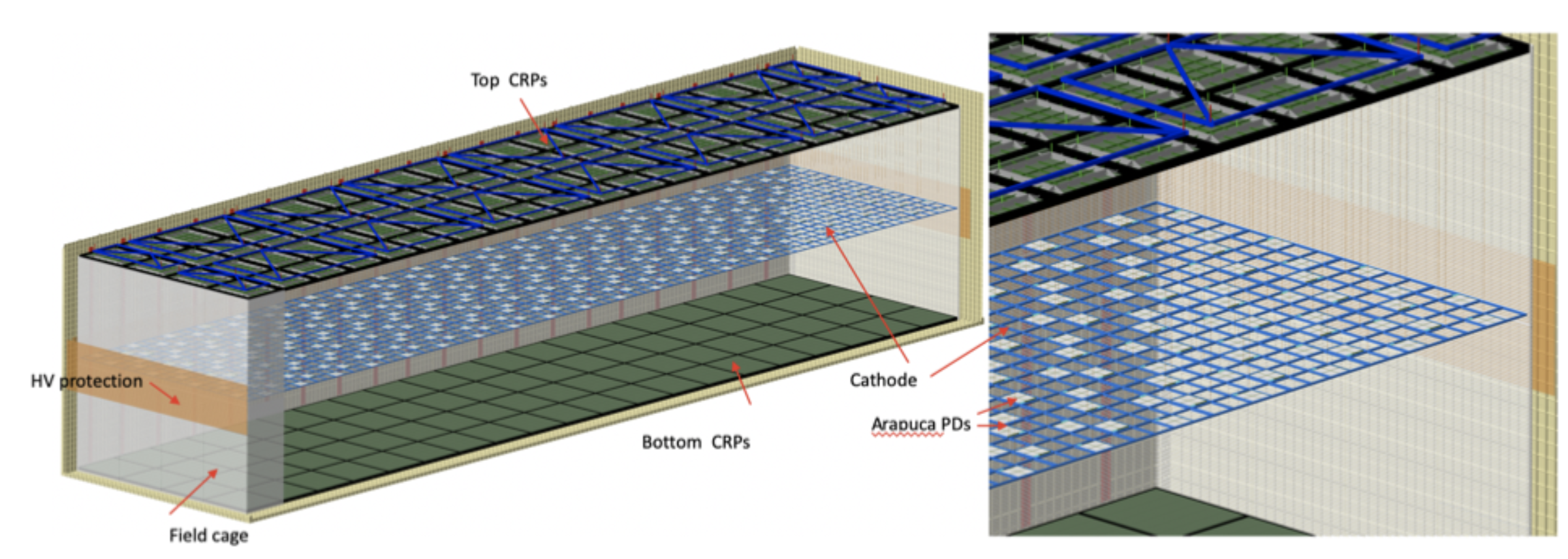
The vertical drift concept for the DUNE FD2 LArTPC. The sketch shows a cut off of the detector, with the top and bottom CRP readout modules, the cathode at mid height, integrating Photon detectors. The Field Cage surrounding the Drift volumes is also partially shown.
The FD2-VD design will implement an upgraded version of the photon detector (PDS) technology in the FD1-HD design, known as the X-Arapuca. The PDS is intended to provide an absolute initial time and interaction point location for neutrino charged current (CC) events. A possible second purpose is to produce a drift-electron-independent PDS trigger for low-energy and SNB events.
The main new components characterizing the Vertical Drift design are: - the perforated PCB Anodes (replacing wire chambers), - the 6.5 m drift field cage requiring extremely high voltage on the cathode (~300 kV), - the photon detectors integrated on the HVS cathode and powered/readout via optical fibers. Although the FD2-VD project is built on solid ground (ProtoDUNE), vigorous R&D is required on these new detector components with a staged approach that started in late 2020 and is continuing into 2022-2023.
To validate the PCB-based anode design specifications and demonstrate the design’s performance, a dedicated testing campaign was conducted at CERN. Small scale prototypes, in the 50-liter LArTPC facility, are exposed to cosmic rays and radioactive sources during several days or weeks. Key goals include study of electron transparency with respect to applied bias voltage, characterization of signal-to-noise (S/N) performance of the anode design with the cold electronics (CE) assembly, characterization of the relationships between the PCB hole size, bias voltage and transparency, and assessment of the signal spread to neighboring induction and collection strips. It was successfully demonstrated that the new anode concept performs equivalently well compared to the traditional wire readout, allowing very efficient 3D reconstruction of complex events as well as excellent calorimetric response in a wide energy range (MeV to GeV).
Large scale tests comprise the operation and the long stability test of the full High Voltage (HV) system operating at the nominal voltage of -300 kV, which was successfully accomplished in NP02 cryostat using an upgraded version of the dual phase detector. In particular, the design of the cryogenic High Voltage distribution was completely revisited to make it absolutely robust against possible failures in liquid Argon, learning from a 2018 incident. The HV system achieved an uptime remarkably larger than 99.9% with stable and continuous operation from September 2021 till March 2022 in ultrapure liquid argon. Cosmic muon tracks of the full 6m drift were recorded with a partial charge readout from the dual phase detector.
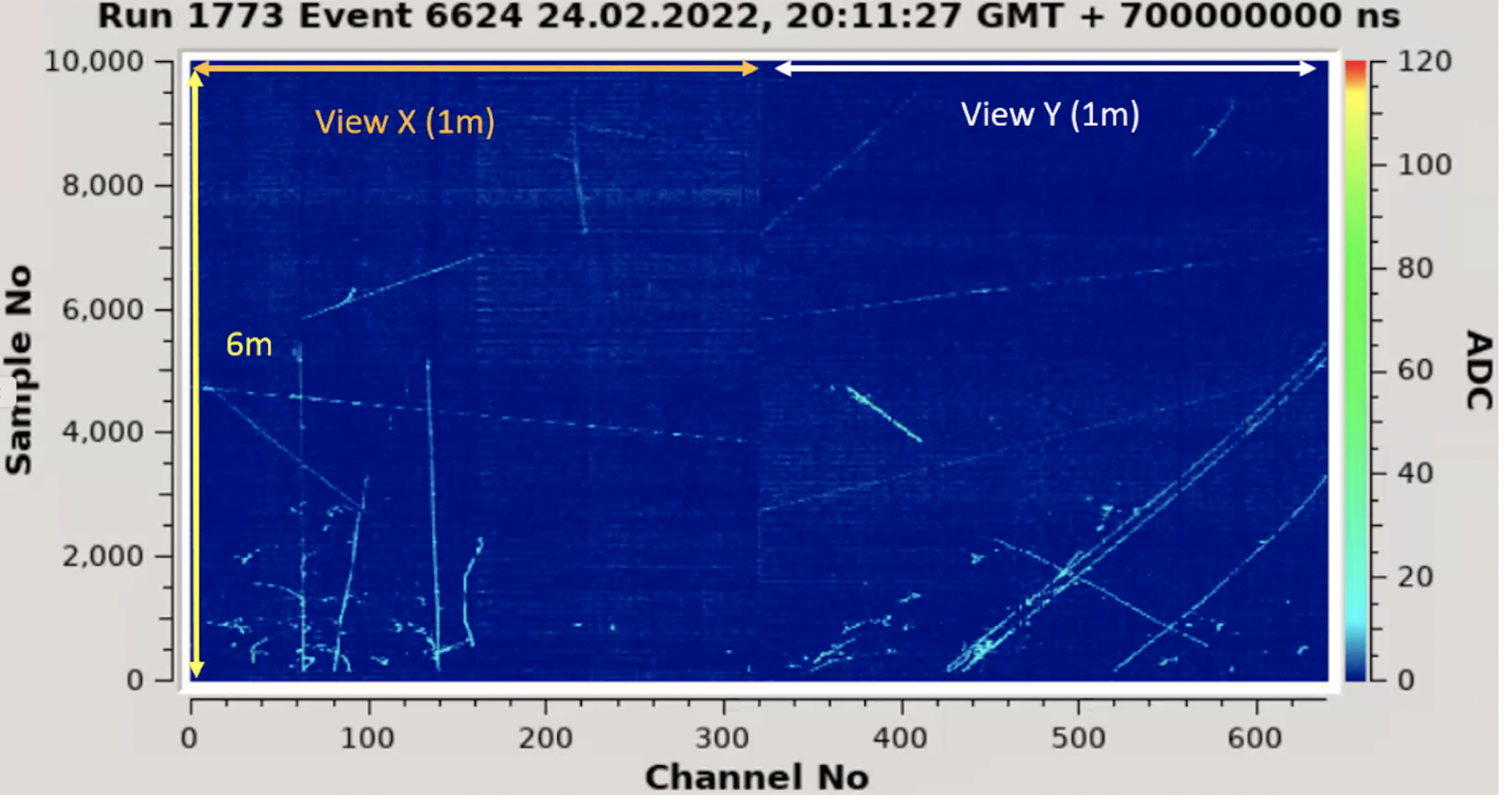
The image above shows the two orthogonal views of a 6 m long drift volume occupied by cosmic ray tracks (mostly muons) recorded in NP02 in February 2022. The top of the detector is at the bottom of the picture.
The top and bottom anode planes of FD2-VD consist of 80 modules of approximately 3 x 3.4 m2 Charge Readout Planes (CRP) with perforated anodes. In 2021, the NP02 cold box was refurbished and upgraded to accommodate a full-scale CRP. The cold box is a shallow and wide cryostat with a cryogenic system capable of ensuring stable thermodynamic conditions and good liquid argon purity. It has a quick turnaround time, so that multiple tests of full-scale readout can be done in a few weeks.
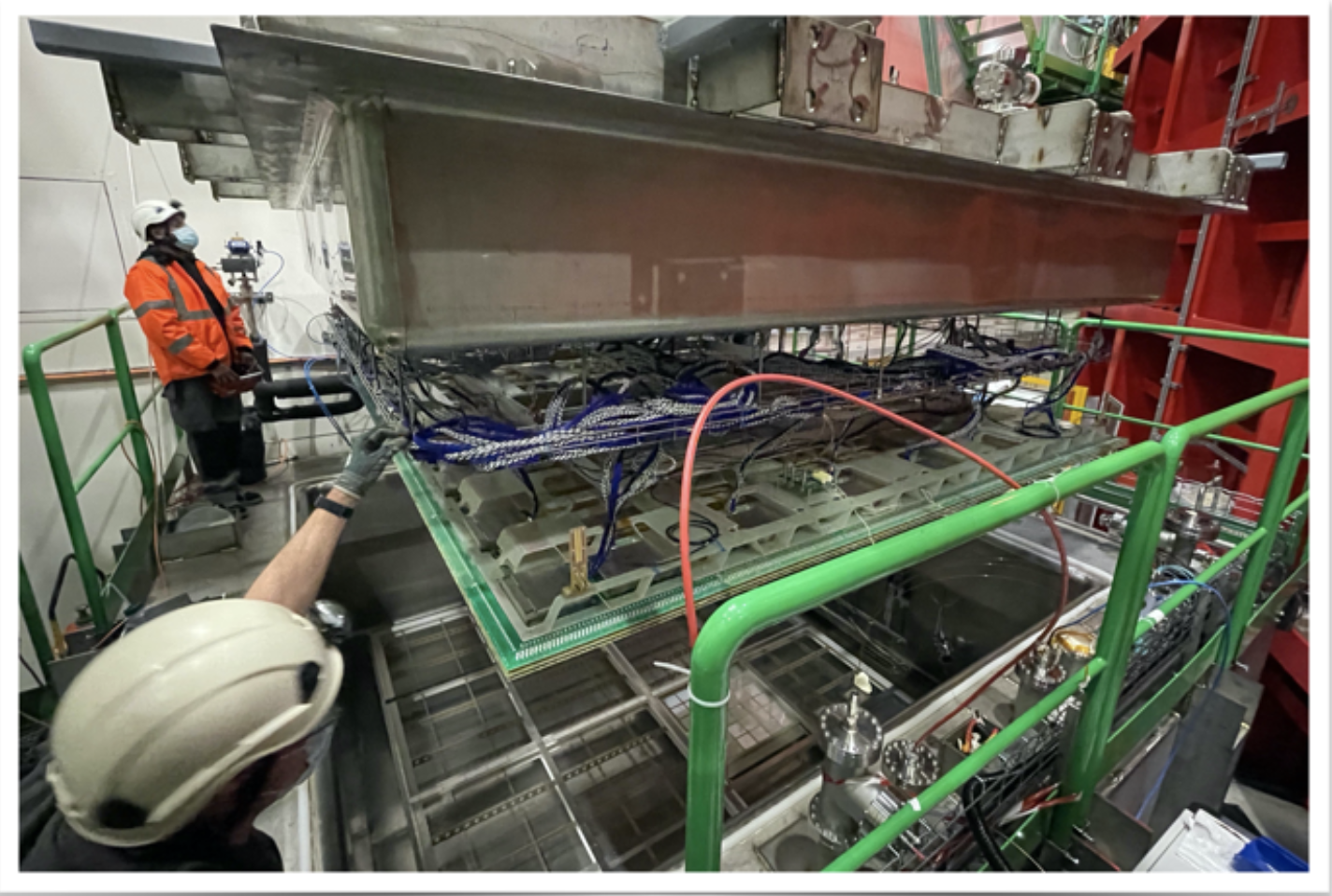
This photo shows the first CRP attached underneath the cold box lid being inserted into the cold box at the end of last year.
A major milestone in the development of the charge readout for the Vertical Drift was realized when the first full scale CRP, equipped with the two types of electronics (Top Drift Electronics, TDE, and Bottom Drift Electronics, BDE) – planned for DUNE-FD2, was tested in November and December 2021. Tracks from cosmic muon were recorded in the LAr of the coldbox with both types of electronics.

Two examples of signals from the BDE collection layer recorded in the cold box test. A muon releasing a delta ray (left) and an electromagnetic shower developing for the 25 cm of drift length (right).
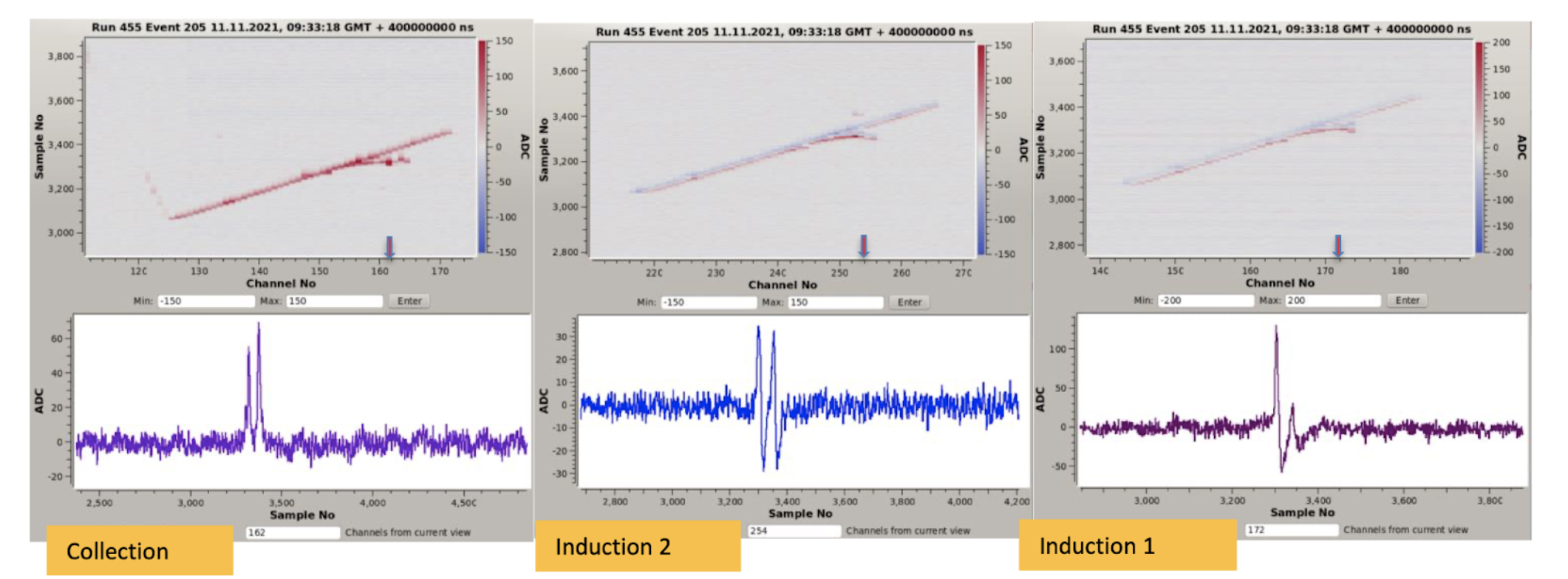
Raw (unfiltered and unprocessed) waveforms of a cosmic muon with a delta ray from the three views recorded with the TDE from the first cold box test.
During 2021, the photon detectors, X-Arapuca’s (light trapping systems based on SiPM’s as active detectors), were successfully tested in the NP02 cold box, after intense R&D devoted to development of a novel powering and readout design based on Power-over-Fiber (PoF) techniques and electro-optical converters (SoF) working in cryogenic environments for the voltage isolation of sensors and electronics from the power source. The large area X-Arapuca detector modules equipped with this innovative cold PoF-SoF technology was tested in experimental conditions, electrically floating on the coldbox cathode biased at 10 kV. Power was distributed via optical fiber immune from noise injection to photo-sensors and electronics, and analog signals, detected down to single photo-electron threshold, were transmitted also via fiber without distortions.
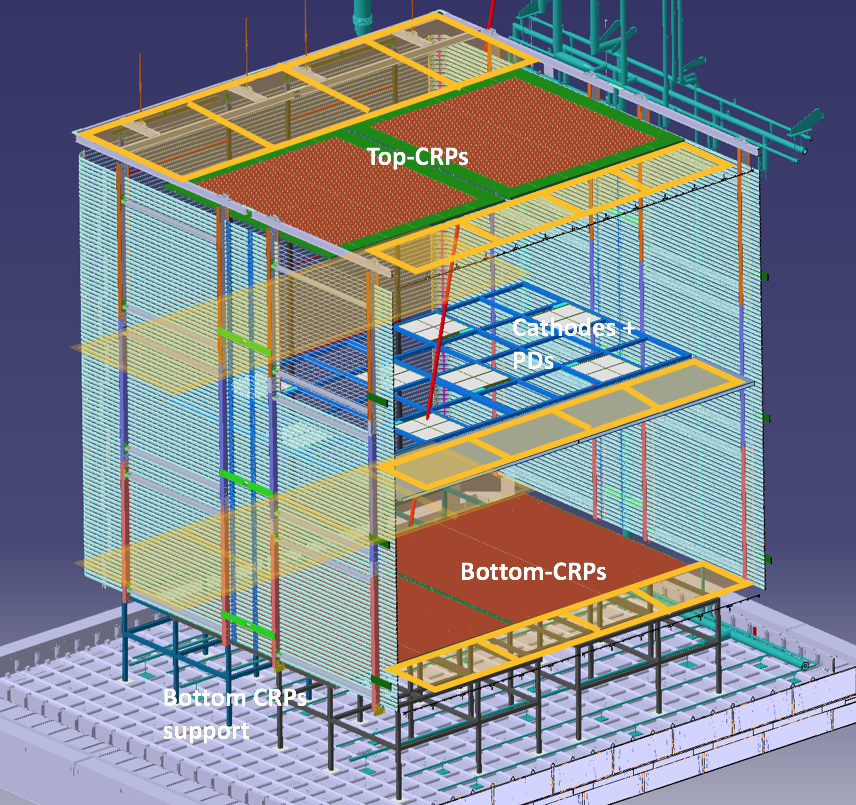
Scheme of the Vertical Drift module-0 detector in the ProtoDUNE-VD NP02 cryostat.
The next major step is the full-scale demonstration of all VD design components (module-0 for FD2). This is planned to take place in the NP02 cryostat where the final validation of the integrated detector will begin at the end of 2022, allowing detector operations in 2023. The NP02 detector will reuse many of the present HV field cage elements and will include two top and two bottom CRPs equipped with TDE and BDE. The cathode will be suspended at mid-height with a 3.2m drift (with the possibility to reach ~1kV/cm at 300kV). X-Arapuca’s will be installed on the cathode and cryostat wall. Detailed engineering of the module-0 layout is ongoing. Similar to NP04, beam exposure is envisaged (hopefully in 2023) for an in-depth investigation of the detector response to electromagnetic and hadronic particles in the ~GeV energy range, relevant for the future neutrino physics with the DUNE far detectors.
